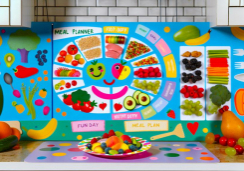Conquer Picky Eating: 4 Strategic Meal Planning Steps
Imagine you're navigating a labyrinth, blindfolded, with nothing but your wits to guide you—that's what planning meals for a picky eater can feel like. You've likely heard every excuse in the book, faced the ultimate standoffs, and maybe even surrendered to the ease of serving the same three dishes on rotation. But it doesn't have to be a battle. With a few key strategies, you can transform mealtime from a power struggle to a journey of discovery for you and your picky eater.
Let's explore four steps that can make meal planning less about frustration and more about cultivating a diverse palette. By identifying acceptable foods, incorporating new varieties, establishing mealtime routines, and reinforcing positive experiences, you're on your way to victory.
Stick with me, and soon you'll uncover the secrets to turning picky eaters into adventurous food explorers. Wondering how these steps can be applied practically at your dining table? Let's just say, buckle up—dinner is about to get a whole lot more interesting.
Identify Acceptable Foods
To lay the groundwork for successful meal planning, start by cataloging the foods your picky eater already prefers, paying close attention to their favored textures and flavors. This initial step is crucial in addressing picky eating because it helps you understand the eating habits that shape your child's current diet. By recognizing these patterns, you're better equipped to introduce new foods that are more likely to be accepted.
Make a list of these preferred foods and note any commonalities they share, such as being crunchy or having a mild taste. These insights offer a valuable framework for expanding their diet. When you try to introduce new foods, choose options with similar characteristics to the trusted favorites. This method increases the chances of food acceptance and can gently nudge your little one's eating behavior towards a more varied and balanced intake.
Incorporate New Varieties
Once you've pinpointed your child's preferred foods, it's time to carefully select new varieties that align with these established favorites, introducing them in a way that's both gentle and effective. Start by choosing a new food that's similar to something your child already enjoys. For instance, if they love apples, try offering pears. The key is to maintain a nutrient-focused approach, ensuring these new foods contribute to a balanced diet.
When introducing new foods, do so gradually. Offering a small portion alongside familiar foods can make eating something new less intimidating. It's important to keep portion sizes age-appropriate to avoid overwhelming your child. Encourage them to try, but don't pressure them. This can reinforce picky eating behaviors instead of resolving them.
Consistency is crucial. Keep presenting the new food without making a big fuss. Sometimes, a child may need to be exposed to a new food multiple times before they're open to trying it. Incorporating a variety of fruits and veggies is particularly important, as these are often the foods picky eaters reject.
Establish Mealtime Routines
Creating a consistent mealtime schedule can significantly ease the stress often associated with eating for your picky eater, providing a framework that supports the gradual introduction of new foods. By establishing regular meal times, you create a predictable routine that can help your child feel more comfortable and secure, making the prospect of trying a new food less daunting.
Consistency is key when dealing with picky eating. It helps regulate your child's appetite, making them more receptive to eating without resistance. Make sure there's a structured environment at meal times; this reduces anxiety and provides a sense of order and stability. As you plan meals, incorporate new varieties alongside familiar favorites to ensure your child eats a balanced diet.
Strategies for Picky Eaters often include eating as a family, which reinforces mealtime routines and models positive eating behaviors. It's important that you eat better as well, showing your child that trying new food is a normal and enjoyable part of life.
Reinforce Positive Experiences
Acknowledging your child's small victories at mealtime can significantly bolster their willingness to try new foods. Positive reinforcement is key in overcoming picky eating and creating an enjoyable atmosphere around food. When your child takes a small bite of a new food, celebrate it. They'll feel proud and may be more open to trying it again.
Consider these strategies to reinforce positive experiences:
- Celebrate Success
- Praise their efforts, even if it's just a nibble.
- Use stickers or a fun chart to track progress.
- Share their achievements with family members who'd love to hear about their bravery.
- Consistency is Crucial
- Offer new foods several times, without pressure.
- Try introducing the same food in different ways over three days.
- Maintain a routine to build familiarity and comfort with eating.
- Supportive Environment
- Keep mealtime stress-free and focused on the joy of eating.
- Engage in conversations about the flavors and textures they enjoy.
- Encourage them to be food explorers, not just eaters.
Frequently Asked Questions
What Are Some Strategies for Dealing With a Picky Eater?
You can tackle picky eating by gradually introducing new foods, creating fun taste pairings, and encouraging sensory play. Keep meals positive with creative plating and celebrate small wins with positive reinforcement.
What Are the 5 P's of Picky Eating?
You'll tackle picky eating by understanding the 5 P's: picky patterns, texture troubles, taste exploration, flavor acceptance, and sensory sensitivity, while addressing emotional eating and nutritional concerns to minimize mealtime battles.
How Do You Make a Meal Plan for a Picky Eater?
You'll create a picky eater's meal plan by blending nutrient-dense foods with preferred flavors, integrating variety, exploring textures, and considering allergies. Control portions, engage senses, respect preferences, and establish a consistent mealtime routine.
What Are Food Bridges for Picky Eaters?
Food bridges help you introduce new tastes, textures, and flavors to picky eaters through familiar combos and gradual changes like taste pairing, ingredient swapping, and color connections for a comfortable and nutritious meal expansion.
Conclusion
You've learned how to tackle picky eating with savvy meal planning. By identifying foods your child likes and introducing new flavors gradually, you're setting the stage for a lifetime of varied, nutritious eating. Sticking to a mealtime routine and celebrating their adventurous bites also play a crucial role in overcoming picky eating habits.
Keep at it, and remember, each small step is a big win for your little one's health and palate. Your patience and persistence will nourish their body and your family's mealtime harmony.










